Web Strikes Back
(work in progress)
Godfried-Willem Raes
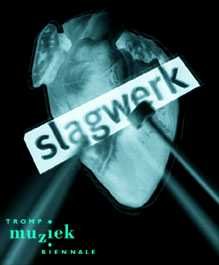
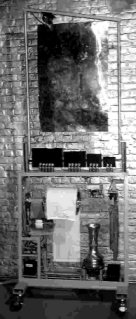 ThunderWood
ThunderWood
automated percussion
by Godfried-Willem Raes
june/july 2000
This instrument is a computer controlled assembly of percussion intruments. All sound sources incorparated in this instrument are non-pitched and share a vague reference to nature sounds.
The instrument can be played by standard MIDI commands, using our GMT software but is also capable of listening to pure algorithmic commands.
The picture to the left was made just before finalization of the instrument, on july 18th of 2000. High resolution pictures are available on request.
The instrument was made and designed to be a part of the
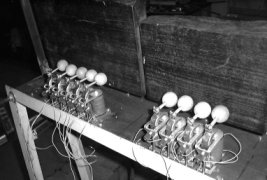 There are 4 woodblocks in the intrument, each provided with a number of solenoids driving the beaters. The lowest woodblock has 5 beaters, the second lowest 4 beaters, the second highest 3 beaters and the highest block got only 2 beaters. The woodblocks are handmade from dark tropical wood and hollowed out. The slit is underneeth the blocks.
There are 4 woodblocks in the intrument, each provided with a number of solenoids driving the beaters. The lowest woodblock has 5 beaters, the second lowest 4 beaters, the second highest 3 beaters and the highest block got only 2 beaters. The woodblocks are handmade from dark tropical wood and hollowed out. The slit is underneeth the blocks.
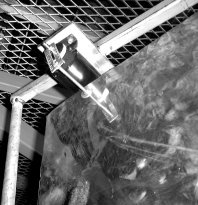 In addition the instrument has as set of low sounding bamboo windchimes, the latter are activated the same way as the brass thundersheet, suspended in top of the instrument..
In addition the instrument has as set of low sounding bamboo windchimes, the latter are activated the same way as the brass thundersheet, suspended in top of the instrument..
A wind-machine was added to the instrument also. This engine uses a strong DC motor (700W / 12V - 210V DC) since this made  precise speed control easy to implement. The motor rotates a perforated cylinder taker from an old laundry machine. Over the cylinder a piece of heavy canvas hangs, causing the wind-noise production proportional to motor speed.
precise speed control easy to implement. The motor rotates a perforated cylinder taker from an old laundry machine. Over the cylinder a piece of heavy canvas hangs, causing the wind-noise production proportional to motor speed.
In the picture, the canvas is removed to better reveal the mechanism. The motor is controlled using one of the reserved 8 bit ports on the main PC board. This data is fed to a DAC connected to a high power opamp, driving the motor. Kevlar may be used instead of canvas to produce the wind noise.
A ratchet , controlled by a synchronuous AC motor with speed reduction mechanism makes the cracling wood sounds in this instrument. As can be seen from the picture, the wood tongues are taken from an old metric size.
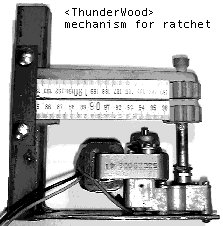 A rainmaker was implemented by filling an RCF 300Watt loudspeaker [a 20cm woofer with glassfiber cone as used in RCF's Monitor 8 enclosures] with fine grains or pellets. The speaker is mounted underneeth the instrument. Over the speaker we mounted a resonator taken from a turkish darbukkah drum. This resonator is mounted upside down. The assembly is placed such that the cone is horizontal. The speaker is driven just as if it were an ordinary solenoid and causes a rain sound when driven with a series of slow pulses. To damp any remaining speaker noises (caused by the square waves) be did provide a steep low pass filter (cut off frequency at 20 Hz). Maximum allowable DC current through the speaker coil should be limited to 1.5A at 12V maximum. With the low pass filter, we can power this part of the circuit from 45V directly.
A rainmaker was implemented by filling an RCF 300Watt loudspeaker [a 20cm woofer with glassfiber cone as used in RCF's Monitor 8 enclosures] with fine grains or pellets. The speaker is mounted underneeth the instrument. Over the speaker we mounted a resonator taken from a turkish darbukkah drum. This resonator is mounted upside down. The assembly is placed such that the cone is horizontal. The speaker is driven just as if it were an ordinary solenoid and causes a rain sound when driven with a series of slow pulses. To damp any remaining speaker noises (caused by the square waves) be did provide a steep low pass filter (cut off frequency at 20 Hz). Maximum allowable DC current through the speaker coil should be limited to 1.5A at 12V maximum. With the low pass filter, we can power this part of the circuit from 45V directly.
more detailed information (including schematics) can be found at:
thunderwood.html



